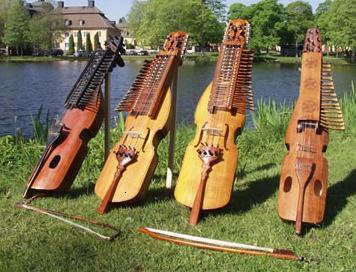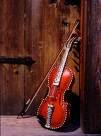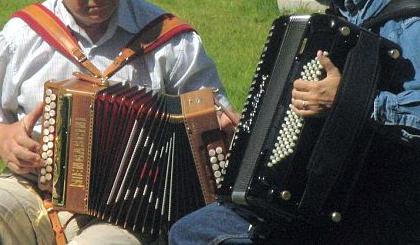Music, Instruments and Musicians
Scandinavian folk music is rich in in 3/4 time music, as well as in the 2/4 and 4/4
time signatures common in modern American music. Several
characteristics make the music interesting for both listening as well as dancing.
In 3/4 time tunes, the beats
within each measure are often of different lengths, calling upon the dancer to
take a different step
length and/or emphasis on each beat.
Typically the rhythm is carried in the fiddle or the other parts, and
percussion instruments are normally not used. This quality encourages the
dancer to develop a keen ear for tempo and rhythm while listening to the melody.
There is a dynamic interaction between the musicians and the dancers, and an old
saying says it takes three to make a dance: the man, the woman, and the fiddler.
Musicians enjoy playing with the phrasing to keep the dancers attentive, and
experienced dancers can answer a signal from a fiddler with a flourish or
ornament in the dance. Although eight-measure phrases are common in
Swedish tunes, Norwegian Hardingfele music is often built around an older
phrasing, in which two-measure units are strung together in a series of themes
and variations.
Key signatures are often modal, outside of the
familiar major and minor keys common in American music. Fiddle tunings may
be unique to a particular region, style of tune, or mood, and are sometimes
given names, such as "Troll Tuning." Older
instruments, such as earlier accordions, did not use the chromatic scale of the
modern piano.
Examples of music used in folk dancing are found on
YouTube. Enter a dance name, such as
schottis, vals, hambo, polska dans, or snoa, and look for the videos of
traditional Scandinavian dance (dans). Entering the name "Bruce Sagan" in
the YouTube search box, will find videos of this American musician playing
traditional tunes.
The Instruments
The fiddle (violin) is the most common instrument for dance
tunes. Two instruments that are uncommon in the United States are
characteristic of Scandinavian music and produce music that is beautiful for
listening as well as dancing.
Nyckelharpa (Swedish Keyed Fiddles)
The nyckelharp (keyed fiddle) predates the flat fiddle
(violin) by several centuries. It has developed into a versatile instrument
with three rows of string dampers actuated by finger keys. The many
strings give the music a very rich, distinctive quality. It is
associated with the province of Uppland and certain Swedish polska dances.
Photo courtesy of Esbjörn Hogmark. (Web link below.)
|
 |
|

|
The Hardingfele (Hardanger Fiddle)
The hardingfele (Hardanger fiddle) contains four to five additional sympathetic strings
underneath which are not bowed but resonate with the upper, bowed strings. There are many
different tunings which can give the music qualities ranging from ethereal to
haunting. It is often ornately decorated with rosemaling on the body,
mother of pearl inlay on the neck and a carved figure
on the neck. The fiddles developed in isolated parts of Norway and are
integral to several types of Norwegian dance, such as the Springars (running
step dances) and Gangars (walking step dances) from the interior valleys of the
country. The Hardingfele is played for listening tunes as well as
dance tunes. About 3,000 tunes and variants (variations) are known in
Norway for the instrument, and many others have probably been lost over time.
Photo courtesy of www.touristphoto.no
|
Other Instruments
The accordion is often used for dance music,
as is the button box accordion and willow flute. Sometimes
used include the munnharpe (Jew's harp), Säckpipa (Swedish bagpipe), langeleik, and hurdy gurdy.
Other traditional instruments include the bukkehorn (goat horn) and neverlur
(birch bark horn), particularly in Norway; these horns were developed by
mountain farmers to project sound over long distances.
Some
dances are traditionally done to sung tunes with or without words as well,
and there is a tradition of song dances from certain regions.
Photo by
Nick Jensen.
|
 |
Dance musicians in our area
Tim Rued's music and life are at:
http://www.folksweden.com/
Sarah Kirton also plays fiddle for dances and can be reached at
sarah.kirton
(at) sbcglobal.net
Lennart
Kullberg plays with
Fresno's Great Danes and in the Fresno Spelman.
Musicians in other areas
Karen Myers and
her music
can be heard at her web site:
www.KarenLMyers.org
A great deal of information on Scandinavian folk music and instruments is listed
on Karen's site, along with recordings of sample tunes.
Bruce Sagan's work and musicianship are at his
web site.
The Nyckelharpa Forum and
Esbjörn Hogmark can be reached at: http://nyckelharpansforum.net
Some information from the Ålesund
Spelemannslag.
Site created by John Hingtgen.
15 Jul 2020 © SAND